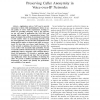118 search results - page 17 / 24 » Performance of random walks in one-hop replication networks |
CORR
2008
Springer
13 years 8 months ago
2008
Springer
Abstract. We propose a dynamic process for network evolution, aiming at explaining the emergence of the small world phenomenon, i.e., the statistical observation that any pair of i...
INFOCOM
2000
IEEE
14 years 25 days ago
2000
IEEE
—Efficient server selection algorithms reduce retrieval time for objects replicated on different servers and are an important component of Internet cache architectures. This pap...
SP
2008
IEEE
14 years 2 months ago
2008
IEEE
— Applications such as VoIP need to provide anonymity to clients while maintaining low latency to satisfy quality of service (QoS) requirements. Existing solutions for providing ...
ICC
2007
IEEE
14 years 2 months ago
2007
IEEE
—Unstructured peer-to-peer networks have gained a lot of popularity due to their resilience to network dynamics. The core operation in such networks is to efficiently locate res...
ICML
2010
IEEE
13 years 9 months ago
2010
IEEE
Markov logic networks (MLNs) use firstorder formulas to define features of Markov networks. Current MLN structure learners can only learn short clauses (4-5 literals) due to extre...

